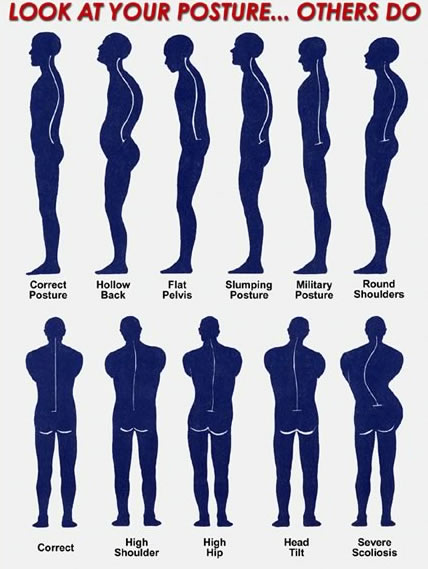Dr Peter Richard Pedersen DC DO NTMD
Graduate - Sydney College of Osteopathy - Sydney College of Chiropractic
International College of Applied Kinesiology
OSTEOPATH
Myofascial Trigger Point Dry Needling Neuromuscular Procedures,
Article: Postural Conditions at a Glance

If you want an example of good posture, just look at a young child – their back shows a graceful ‘S’ curve and their movements are easy and effortless. As we get older, bad habits such as slouching and inactivity cause muscle fatigue and tension that ultimately lead to poor posture. The complications of poor posture include back pain, spinal dysfunction, joint degeneration, rounded shoulders and a potbelly.
You can improve your posture and spinal health by making a few lifestyle adjustments.
Symptoms of poor posture can include:
- Rounded shoulders
- Potbelly
- Bent knees when standing or walking
- Head that either leans forward or backward
- Back pain
- Body aches and pains
- Muscle fatigue
- Headache.
Postural mechanisms
Poor posture interferes with a number of the body’s postural mechanisms including:
- 'Slow twitch' and 'fast twitch' muscle fibres
- Muscle strength and length
- Nervous system feedback on the body’s position in space.
Two types of muscle fibres
Skeletal muscle is made up of two types of muscle fibre – static (often called 'slow twitch') and phasic (often called 'fast twitch'). Generally, static muscle fibres are found in the deeper muscle layers. They help us to maintain posture without too much effort and contribute to balance by ‘sensing’ our position and relaying this information to the brain. Phasic muscle fibres are used for movement and activity.
Static fibres burn energy slowly and can keep working for a long time without tiring. However, phasic fibres quickly run out of steam. Poor posture causes muscle fatigue because it calls on the phasic fibres instead of static fibres to maintain the body’s position.
Muscle strength and length
Over time, poor posture that demands support from phasic fibres causes the deeper supporting muscles to waste away from lack of use. Weak, unused muscles tend to tighten and this shortening of muscle length can compact the bones of the spine (vertebrae) and worsen posture.Nervous system feedback on the body’s position in space
The deeper layers of muscle are concerned with ‘sensing’ our position in space and relaying this information to the brain. If this function is taken over by muscles that mainly contain phasic fibres, the brain gets an incomplete picture. The brain assumes that the body needs to be propped up to counteract the effects of gravity, so it triggers further muscle contraction. This adds to the general fatigue and pain felt by the person with poor posture.Listen to your body
Good posture feels effortless, which is why traditional ‘good posture’ suggestions like throwing your shoulders back and sticking out your chest may feel uncomfortable too. Instead, listen to your body. Make minor adjustments while standing and sitting. Which position feels the easiest and most graceful?
In most cases, concentrating on other tasks (such as work) can direct attention away from any feelings of physical discomfort. Get into the habit of regularly tuning in to your body. If you feel muscle tension or fatigue, move into another position.
Improve your general posture
-
Remember the rule of ‘curve reversal’ – for example, if you’ve been leaning over your desk, stretch back the other way.
-
Perform stretching exercises two or three times a week to boost muscle flexibility.
-
Exercise regularly to improve muscle strength and tone.
-
Stretch your neck muscles regularly by turning your head from one side to another.
-
Your abdominal muscles support your lower back, so make sure they are in good condition. Do ‘abdominal crunches’ (lie on your back and curl your ribcage and pelvis as close together as possible) rather than straight-backed sit-ups (which exercise the muscles of the hips and thighs).
-
Avoid standing on one foot for long periods of time.
-
Cross your legs at the ankle, rather than the knee.
Maintain good posture
-
Avoid sitting in soft, squashy chairs.
-
Use lumbar rolls to support your lower back when sitting in regular chairs or driving the car.
-
Switch to ergonomic chairs in the office or for any activity that requires you to sit for long periods of time.
-
Make sure your mattress is supportive enough to keep your spine straight when lying on your side.
-
Use a pillow that supports your neck.
-
Keep your back straight and use your thigh muscles when lifting heavy weights.
Things to remember
-
The complications of poor posture include back pain, spinal dysfunction, joint degeneration, rounded shoulders and a potbelly.
-
Suggestions to improve your posture include regular exercise and stretching, ergonomic furniture and paying attention to the way your body feels.
-
See us for further information and advice.
- ... see also > Spinal Curves
Article by Dr Peter Pedersen
Your Health Matters
Group Practice since 1980
63 Warrener Street
Corner of
Nerang-Broadbeach Rd
Nerang - Gold Coast
Exit 71- East side of the M1
Monday to Friday:
8am - 5:00pm
Saturday:
8am to 2pm...ish
55273001 or 55273002
Clinic Modalities:
Osteopathy, Chiropractic
Acupuncture and TCM
Massage
Trigger Point Dry Needling


